Sections on this page:
- Intro
- What is a total solar eclipse?
- What will I see during the total solar eclipse?
- From what locations will the total solar eclipse be visible?
- When will the total solar eclipse occur, and how long will it last?
- Safe Viewing
- What else should I know before viewing the eclipse?
- How to Film or Photograph the 2017 Solar Eclipse Like a Pro
- Eclipses In History
By Space.com
On August 21, 2017, a Total Solar Eclipse will occur along a track running across the Continental USA from Salem, Oregon to Charleston, South Carolina.

On August 21, 2017, people across the United States will see the sun disappear behind the moon, turning daylight into twilight, causing the temperature drop rapidly and revealing massive streamers of light streaking through the sky around the silhouette of the moon. On that day, America will fall under the path of a total solar eclipse.
The so-called Great American Total Solar Eclipse will darken skies all the way from Oregon to South Carolina, along a stretch of land about 70 miles (113 kilometers) wide. People who descend upon this "path of totality" for the big event are in for an unforgettable experience.
Here is our complete guide to the 2017 total solar eclipse. It includes information about where and when to see it, how long it lasts, what you can expect to see, and how to plan ahead to ensure you get the most out of this incredible experience.
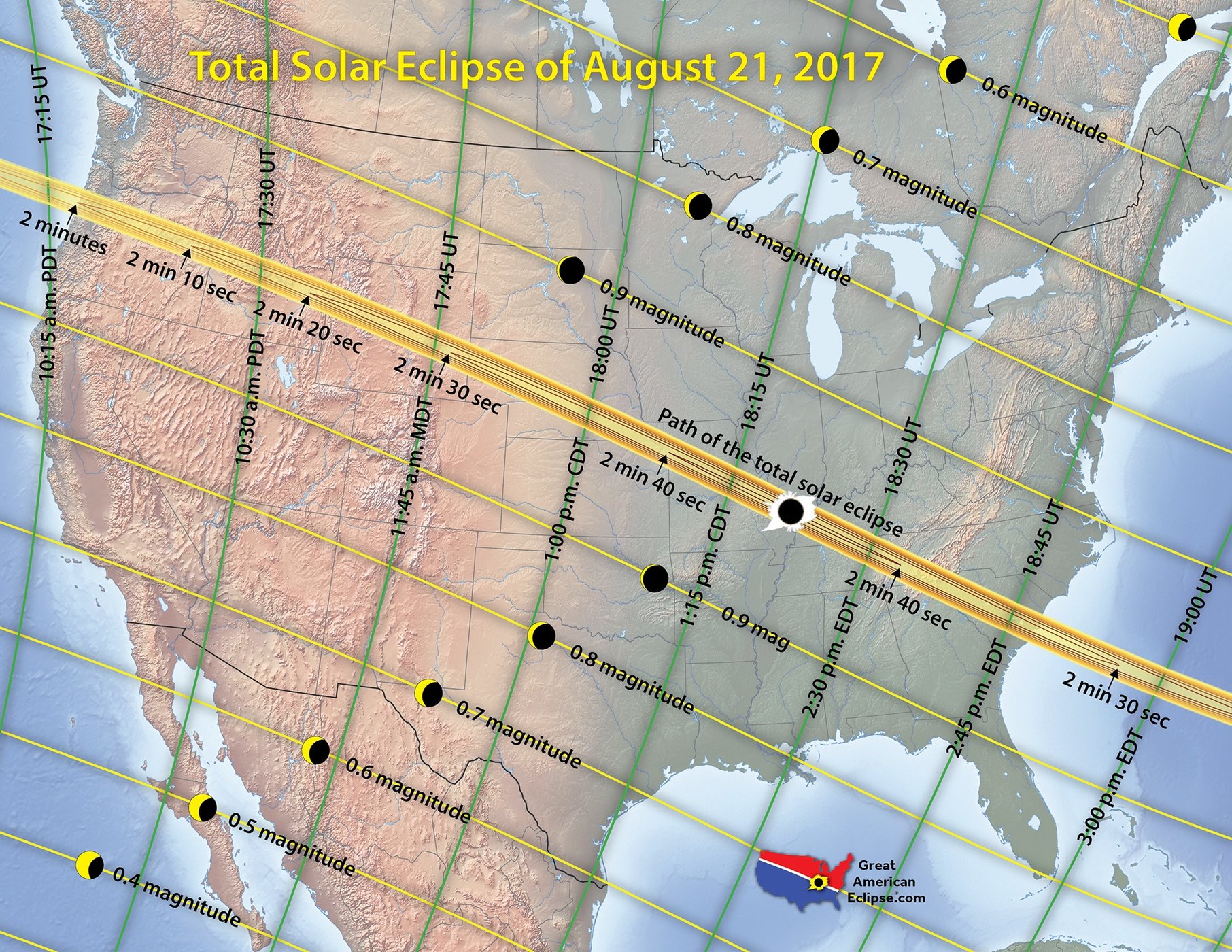
Image Credit: Michael Zeiler, GreatAmericanEclipse.com
Looking directly at the sun, even when it is partially covered by the moon, can cause serious eye damage or blindness. NEVER look at a partial solar eclipse without proper eye protection. See our complete guide to find out how to view the eclipse safely.
What is a total solar eclipse?
A total solar eclipse occurs when the disk of the moon appears to completely cover the disk of the sun in the sky. The fact that total solar eclipses occur at all is a quirk of cosmic geometry. The moon orbits an average of 239,000 miles (385,000 kilometers) from Earth – just the right distance to seem the same size in the sky as the much-larger sun. However, these heavenly bodies line up only about once every 18 months.
Outside the path of totality, skywatchers in the continental U.S. and other nearby areas will see a partial solar eclipse, in which the moon appears to take a bite out of the sun's disk. Two to five solar eclipses occur each year on average, but total solar eclipses happen just once every 18 months or so.

Image Credit: Karl Tate, SPACE.com Contributor
What will I see during the total solar eclipse?
During a total solar eclipse, the disk of the moon blocks out the last sliver of light from the sun, and the sun's outer atmosphere, the corona, becomes visible. The corona is far from an indistinct haze; skywatchers report seeing great jets and ribbons of light, twisting and curling out into the sky.
"It brings people to tears," Rick Fienberg, a spokesperson for the American Astronomical Society (AAS), told us of the experience. "It makes people's jaw drop.”
During totality, the area inside the moon's shadow is cloaked in twilight – a very strange feeling to experience in the middle of the day. Just before and just after totality, observers can see this cloak of darkness moving toward them across the landscape, and then moving away.
These effects are not visible during a partial solar eclipse, so skywatchers are encouraged to see if they are inside the path of totality during the total eclipse.
One unique phenomenon that occurs at the beginning and end of a total solar eclipse is known as Baily's beads. Baily's beads refers to small slivers of sunlight, or beads, that are still visible around the Moon during a total solar eclipse. These “beads” are the result of light filtering through the irregular surface of the Moon as a result of topographical features like mountains, craters, and valleys. Another unique view, known as the diamond ring effect, is seen when only one bead is visible. Baily's beads are named in honor of Francis Baily (1774 – 1844) who provided an explanation for these small slivers of light in 1836.

During totality, the naked eye star Regulus, in Leo the Lion, will be sitting less than one degree (about a finger's width) to the upper left of the eclipsed Sun. Reddish Mars, though slightly dimmer at magnitude 1.77, will be 8 degrees (just under a fist diameter) to the right of the eclipse. Looking farther along the same line, very bright Venus will be located 34 degrees to the lower right (west) of the eclipse. Look 51 degrees in the opposite direction for bright Jupiter. For a challenge, you can hunt for Mercury, at visual magnitude 4.2, sitting only 10 degrees to the left of the eclipse.
From what locations will the total solar eclipse be visible?
The path of totality for the August 21, 2017, total solar eclipse is about 70 miles wide and stretches from Oregon to South Carolina. It passes through Idaho, Wyoming, Nebraska, Kansas, Missouri, Illinois, Kentucky, Tennessee, Georgia, North Carolina and South Carolina. You can use the interactive eclipse map in Eclipse Safari to zoom in on the path of totality and find out the exact locations from which it will be visible.
You may also want to attend one of the many eclipse parties and organized events taking place around the path of totality.
When will the total solar eclipse occur, and how long will it last?
The timing of the total solar eclipse and its duration both depend on where you are inside the path of totality.
At most, the moon will completely cover the disk of the sun for 2 minutes and 40 seconds. That's about how long totality will last for observers positioned anywhere along the center of the path of totality. As you move toward the edge of the path, the duration of totality will decrease. People standing at the very edge of the path may observe totality for only a few seconds.
Because the shadow of the moon will move from west to east, totality will occur later in the day the farther east you travel. Use Eclipse Safari to find out exactly when totality will occur and how long it will last in the location where you plan to observe the eclipse. Just click on a spot on the map, and specific times will be listed in the event time table.

Safe Viewing
NEVER LOOK DIRECTLY AT THE SUN. Permanent eye damage can result. Instead, proper telescope filters or protective glasses from reputable astronomy dealers should be used.
Check our Eclipse Store for solar products that feature Solar Safe filter technology providing the ultimate protection from harmful solar radiation, including both IR and UV light.
- Eclipse Shades
-
Anyone planning to view the total solar eclipse of 2017 should get a pair of solar viewing glasses. These protective shades make it possible for observers to look directly at the sun before and after totality. The following five companies sell eclipse glasses that meet the international standard (ISO 12312-2) recommended by NASA, the AAS and other scientific organizations: Celestron, Rainbow Symphony, American Paper Optics, Thousand Oaks Optical and TSE 17.
Sunglasses cannot be used in place of solar viewing glasses.

Eclipse shades are a safe and inexpensive way to view the Sun. - Telescope Solar Filters
-
For serious eclipse observing, a telescope with a full-aperture solar filter is best. Such filters are attached on the end of the telescope that is facing the Sun, not the side facing your eye. This will cause most of the sunlight to be filtered out before entering your telescope.
The eclipse should be watched only with an appropriate solar filter. If your telescope comes with a filter that screws into the eyepiece, discard it immediately! Such filters have been known to crack under the intense heat of the Sun's magnified image.
Lastly, never look at the Sun directly through your smaller, finder scope as it will cause permanent eye damage. It is strongly advised to cover the finder scope before the event so as to avoid looking through it accidentally.
Safe solar filters are available in many different sizes suitable for any telescope. They fit snugly over the front of the telescope and reflect away 99.99% of the Sun's light and heat, allowing a safe 0.01% through. The Sun appears as a white circle set in a perfectly black sky, because no sky light is able to penetrate the filter.
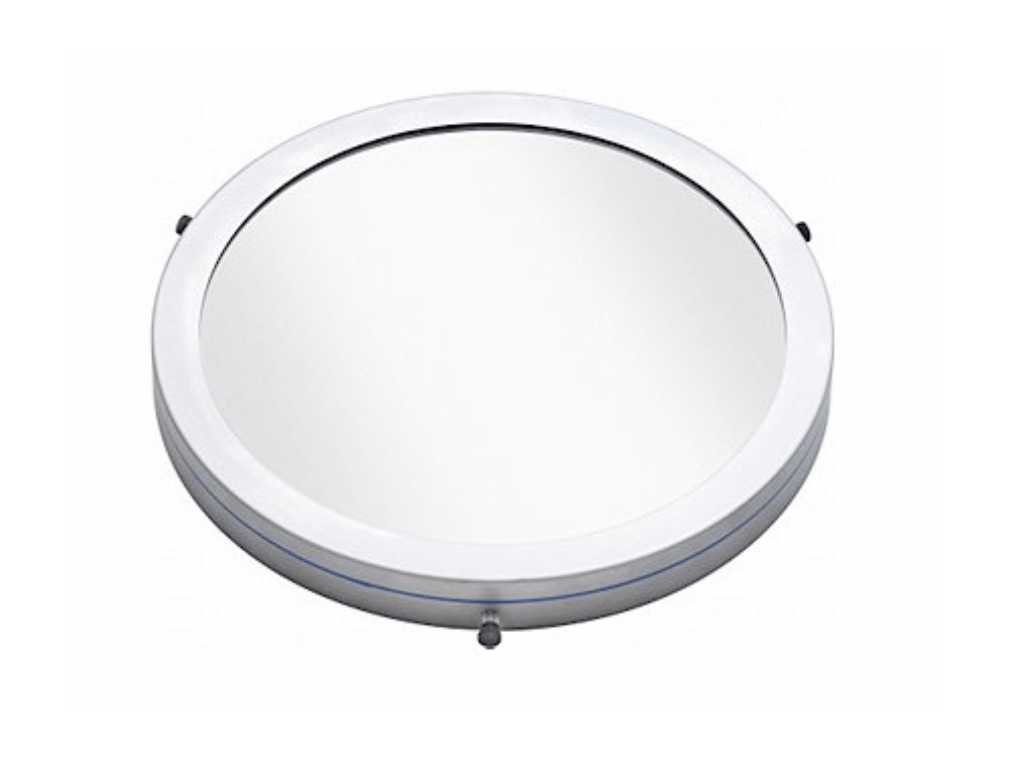
A telescope fitted with a safe full-aperture solar filter will provide safe views of eclipses, transits, and sunspots. - A Simple Pinhole Camera To View the Solar Eclipse
-
Viewing the Sun directly, particularly during the solar eclipse, is dangerous without a proper solar filter. A safer way to view an eclipse, that requires no expenditure and minimal preparation, is to use a pinhole camera.
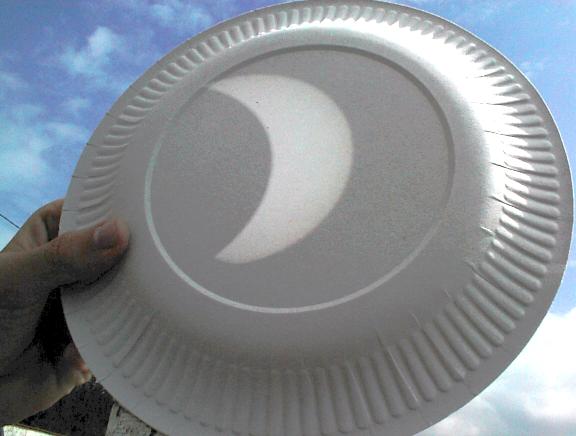
A safer way to view an eclipse is to use a pinhole camera to project the eclipse image. Make a tiny hole (1-3 mm) in a sheet of paper and hold it up, blocking the Sun. Hold another sheet of paper (or a paper plate) in front of the pinhole, allowing the Sun's light to pass through the pinhole and onto the paper. This will allow you to view an inverted image of the Sun.
If you prefer to be indoors, place a large sheet of cardboard in a west-facing window. Make a small hole (about 5mm or 1/4 inch) in the middle of the cardboard. This will act as the lens. Project the image of the Sun on another piece of cardboard at least 3 meters (10 feet) away. This will provide a large enough image so that the Moon will be easily visible. This also has the advantage that a large number of people can view the image simultaneously. It gets people indoors to observe, and lessens the risk of quick peeks at the Sun with unprotected eyes.
ImportantUnacceptable filters to view the Sun include sunglasses, color film negatives, black-and-white film that contains no silver, photographic neutral density filters, and polarizing filters. Although these materials have very low visible-light transmittance levels, they transmit an unacceptably high level of near-infrared radiation that can cause a thermal retinal burn. The fact that the Sun appears dim, or that you feel no discomfort when looking at the Sun through the filter, is no guarantee that your eyes are safe.
- The Sunspotter
-
Another good option for schools and large groups is the Sunspotter. This is a wooden, folded-path, Keplerian telescope that provides a safe and convenient way to view the brilliant light of the Sun. By using a series of mirrors, the device projects a bright 3.25-inch solar image onto a 5-inch white viewing screen. You can use the Sunspotter for viewing the Sun, eclipses, transits, and for daily record keeping.
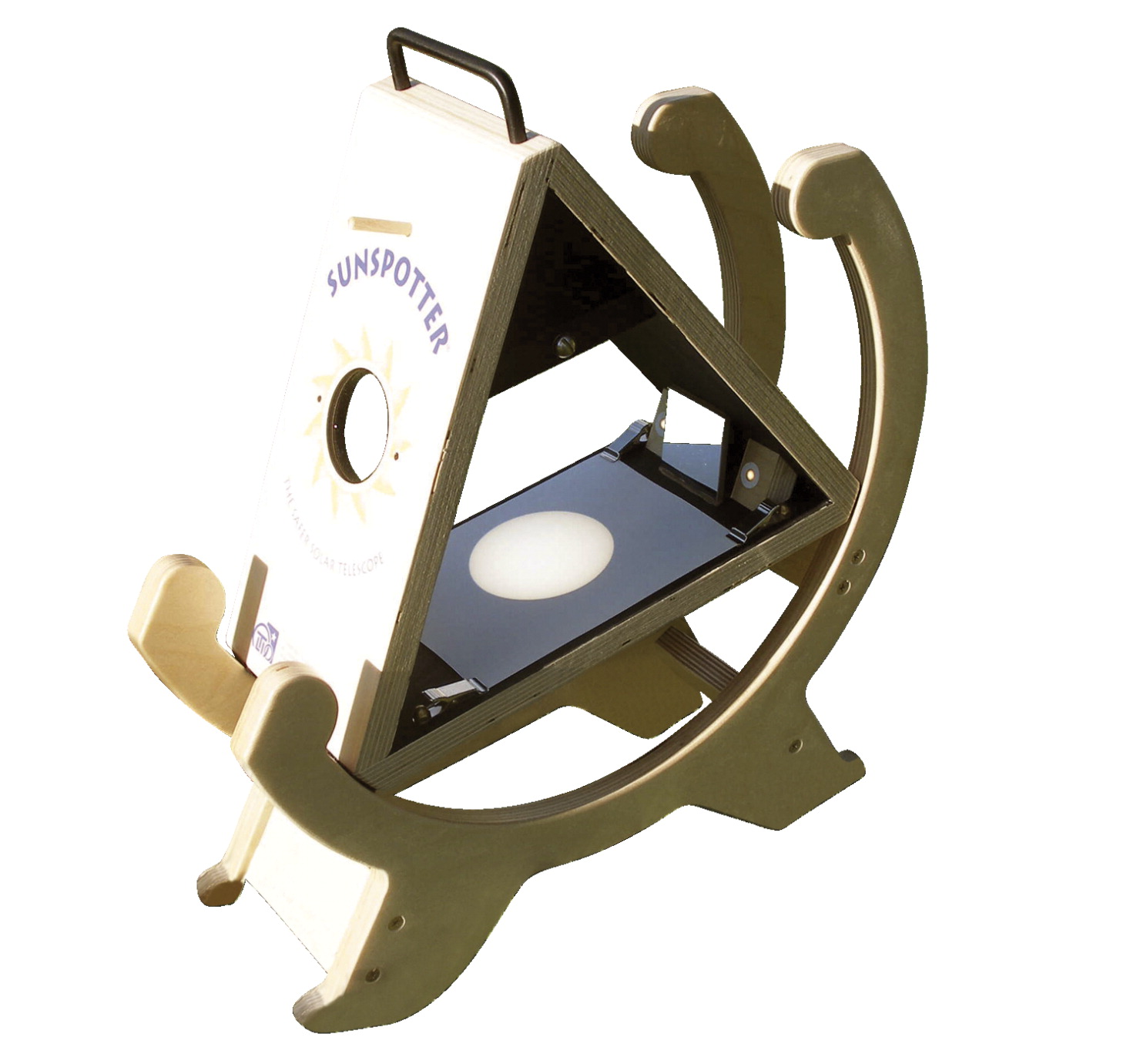
A Sunspotter allows several observers to safely view the Sun's disk. - Inform Others On Eclipse Viewing Safety
-
The transit will occur around mid-day over most of North America, when the Sun is high in the sky, so that many people will notice that something is happening on the Sun and then will be tempted to look at it without adequate protection. The risk of permanent eye damage to the general public is extremely high, unless amateur astronomers take an active role in publicizing the danger, and providing safe alternatives.
Amateur astronomers like yourself are aware of the dangers, and will take adequate precautions with solar filters. The general public will not, and are at great risk. It is our responsibility to educate people of the dangers, and provide alternative safe viewing situations.
Finally, take the opportunity to do “sidewalk astronomy” by setting up telescopes with proper filtration for viewing by the general public at schools, libraries, and outdoor shopping malls. This will encourage the public to practice safe viewing, especially if you can hand out free eclipse glasses.
- Try it Out!
-
Shadows become quite interesting. As the sunlight is filtered through leaves, you can enjoy tiny eclipse images sparkling on the ground. Each tiny hole formed from the spaces between the leaves allows a projection of the eclipse image to shine through onto the ground, much like a "pinhole projector." Nature provides many natural pinholes: you will see miniature solar images everywhere. You can also use an object like a kitchen skimmer (or anything with small holes) and project the tiny eclipse images on a surface such as your t-shirt! If you don't have a kitchen skimmer, hold your fingers, crossed together, over your head. The shadows produced by the tiny spaces in between your fingers will produce miniature eclipse images.
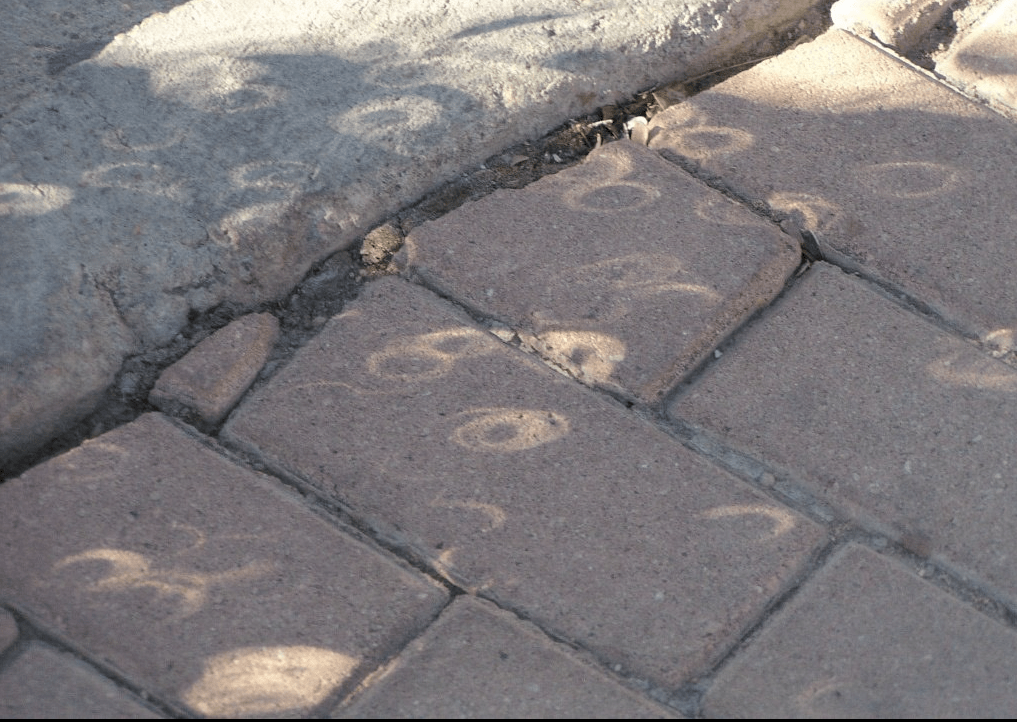
In Madrid, to view the October 3, 2005 annular eclipse of the Sun, astronomer Philippe Haake met a friend who had another inspiration. The result, a grid of small holes in a kitchen strainer produced this pattern of images on an “eclipse shirt.”

Image Credit: Philippe Haake In the 2005 annular eclipse, Steve G.S., captured little annular eclipse images projected through gaps between the leaves of a tree, which formed pinhole cameras. Credit: Steve G.S., from the 2005 annular eclipse in Spain.
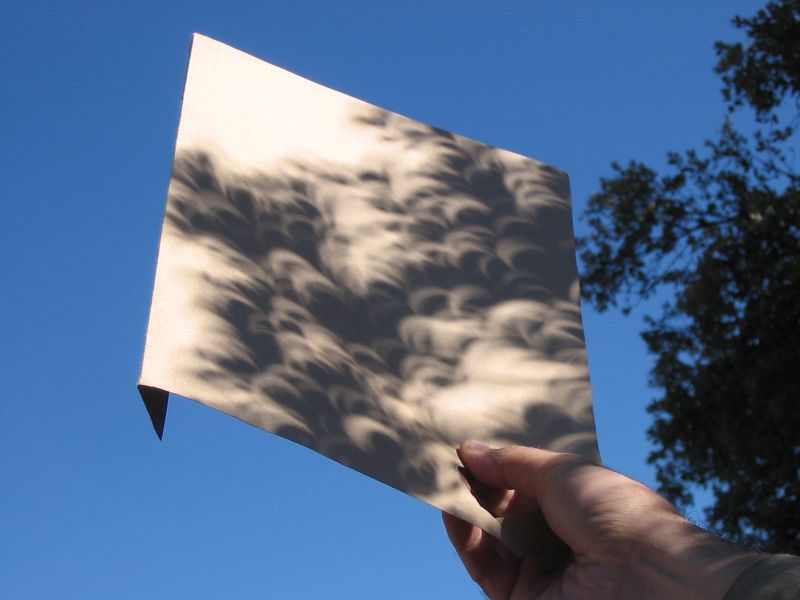
Holes in the leaf canopy produce a pinhole effect that project images of the eclipse on a sheet of paper. 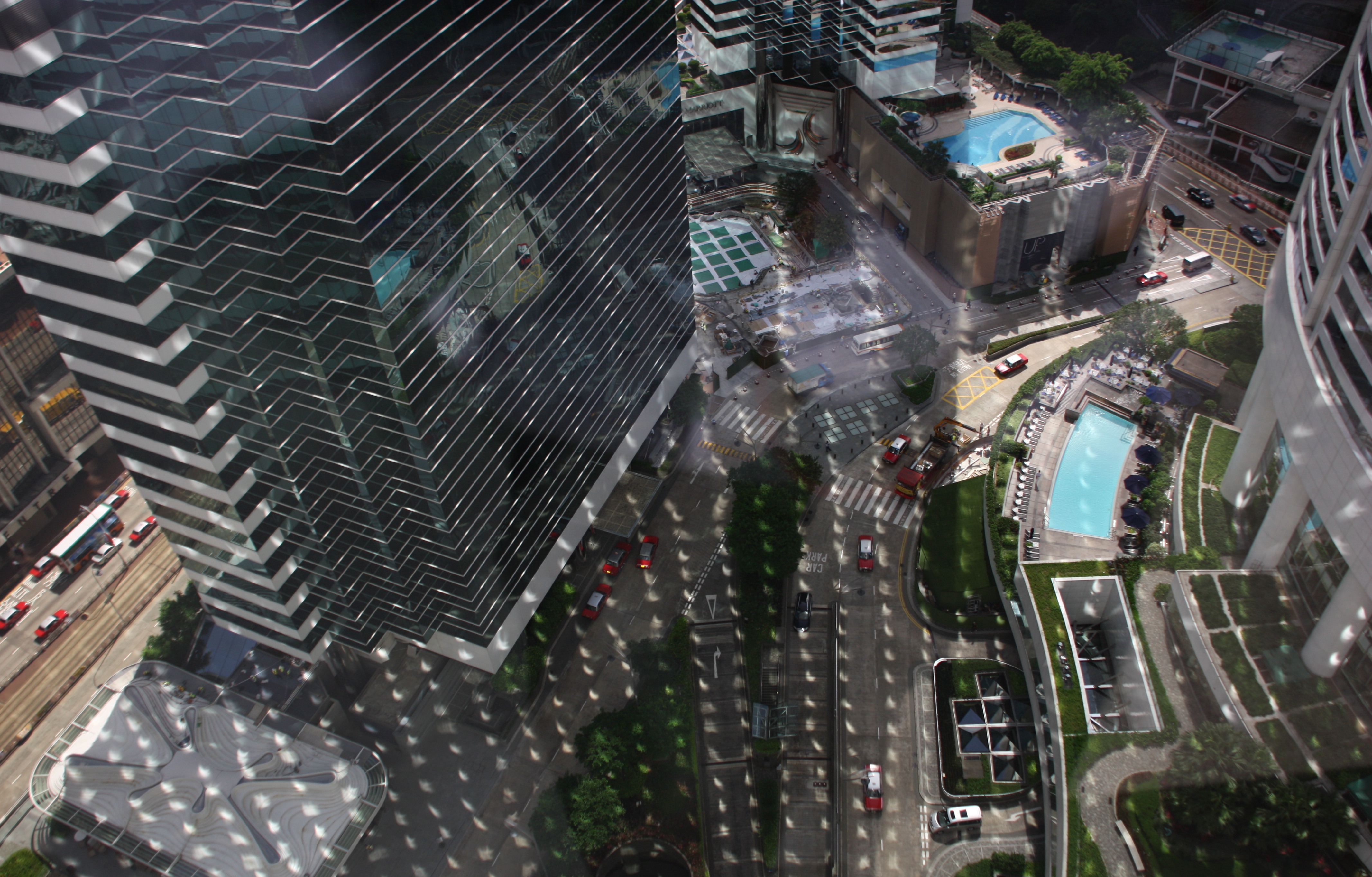
On July 22, 2010, a partial solar eclipse was enjoyed by the inhabitants of Hong Kong as images of the partially eclipsed Sun adorned the city itself. In this down looking photo, taken at 9:40am local time, a remarkable array of solar eclipse views was created by reflection in a grid of eastward facing skyscraper windows. The photographer's location was the 27th floor of Two Pacific Place.
Image Credit: Alfred Lee
What else should I know before viewing the eclipse?
August 21, 2017, may be one of the worst traffic days in national history, some NASA representatives predict. Although about 12 million people live within the narrow band of totality, approximately 25 million reside within a day's drive of it, and the agency has estimated that the population inside the path of totality may double on the day of the eclipse.
With that in mind, make sure you plan for extra travel time, especially on the day of the eclipse. Most hotel rooms inside the path of totality have been booked for months or years, so you may not be able to stay inside the path the night before.
When selecting a location where you plan to view the eclipse, keep in mind your proximity to food, water, parking and facilities. Attending an organized eclipse event is an ideal way to make sure those things are close by. Traveling even short distances could be difficult in some areas, and midday in the middle of August can mean punishing heat in many parts of the country.
How to Film or Photograph the 2017 Solar Eclipse Like a Pro
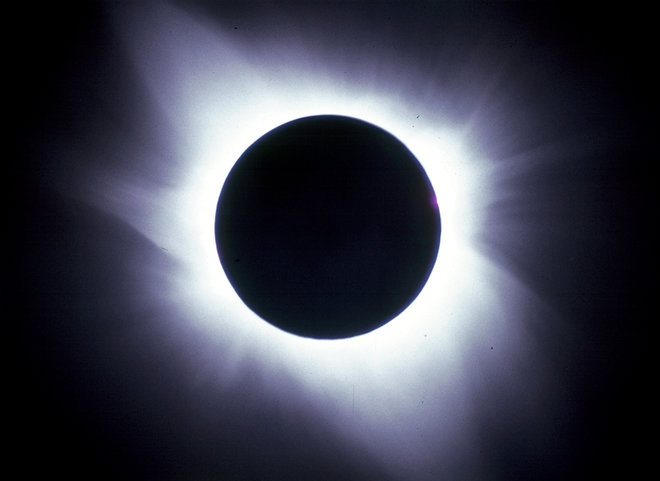
Credit: Imelda Joson and Edwin Aguirre
Here are some pointers to help you increase your chances of success in capturing souvenir images of the greatest celestial show of the decade.
Never look directly at the sun without eye protection, such as solar-viewing glasses or a solar filter for your camera, binoculars or telescope. Failure to do so can result in serious eye injury or permanent blindness. A No. 14 arc-welder's glass filter is also acceptable, but ordinary sunglasses and polarizing or neutral-density filters used in regular photography are not safe and should not be used.
Using the right optics is key
If you are planning to use a digital single-lens reflex (DSLR) camera to capture detailed, close-up shots of the eclipse's partial phases, Baily's beads, diamond rings, prominences and the inner corona and outer corona, you'll need to shoot through a telephoto lens or telescope of sufficient focal length, say, 500 millimeters or more. This will give you a reasonably large image of the sun's disk in the camera frame. (See the diagram in the accompanying photo gallery.)
To calculate the size of the sun's image in the frame of a DSLR with full-format (36 x 24 mm) sensor, divide the focal length of the lens in millimeters by 109. For example, a 500-mm lens will produce a solar image 4.6 mm across; a 2,000-mm lens will yield a solar disk 18.4 mm in diameter. DSLRs that use APS-C-size sensors (approximately 22 x 15 mm on Canon consumer DSLRs) will show a smaller field for a given lens due to the focal-length crop factor of 1.6.
With a telephoto lens, you can use a 2X teleconverter to boost its effective focal length. With a telescope, you can insert a Barlow lens or use the afocal imaging or eyepiece-projection technique.
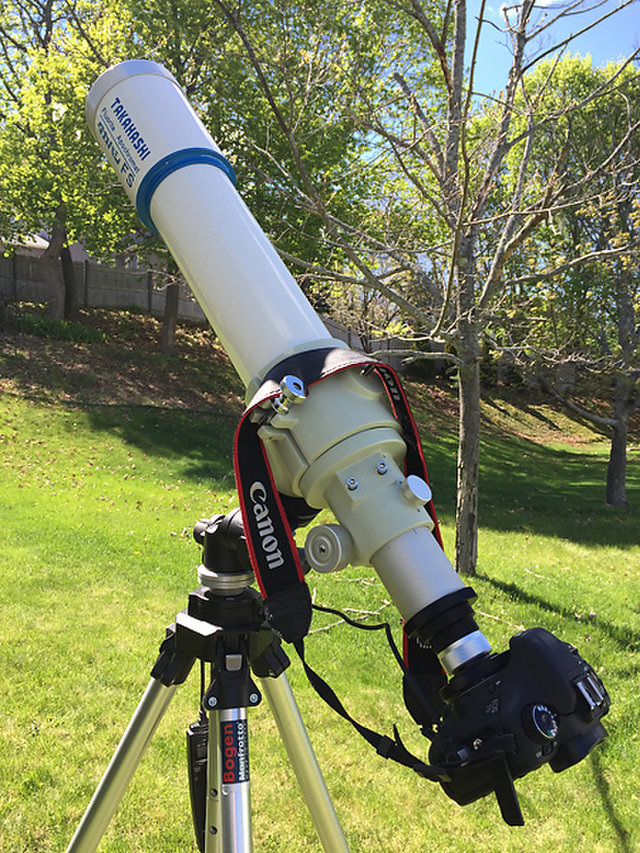
Credit: Imelda Joson and Edwin Aguirre
Keep it steady
To get jitter-free shots, use a sturdy tripod or mount to support your camera setup. Don't try to hold it by hand. Make sure your tripod and head are beefy enough to carry the full load of your imaging gear. Carbon-fiber tripods are stronger and lighter than regular aluminum tripods, but they cost a bit more.
Keep the tripod low to the ground to minimize vibrations. If you need to raise the tripod's height, extend the legs, not its center column. If possible, place a vibration-suppression pad under each leg. You can also hang a heavy object, such as a backpack or a jug of water, under the tripod's center post to improve its stability.
Try to keep your setup as portable and easy to assemble and operate as possible. Portability is the key if you need to relocate in a hurry to a different site to escape clouds.
Track the sun
If your camera setup has a relatively short focal length, then a fluid pan head offers smooth guiding when you're manually tracking the sun, which moves 0.25 degrees per minute across the sky. Keep your exposures short (no more than a second or so) to prevent the image from smearing due to Earth's rotation.
If you're using a telescope or super-long-focus telephoto lens, then an equatorial mount with slow-motion controls or motor drive would be ideal. A motor drive is convenient since it keeps the sun centered in the camera frame as you focus, adjust the exposure settings and take your shots. However, an equatorial mount must be polar-aligned, and unless you're planning to camp out at your observing site the night before the eclipse, you'll need to do that in the daytime.
If you don't want to deal with polar alignment and telescope counterweights, a better alternative would be to use a computerized GoTo altazimuth mount, such as iOptron's AZ Mount Pro. This compact, portable and lightweight mount has built-in sensors and GPS for easy setup in the field. All you have to do is level the battery-operated unit on its tripod and turn on the power; after a quick initial calibration, the mount will be ready to go.
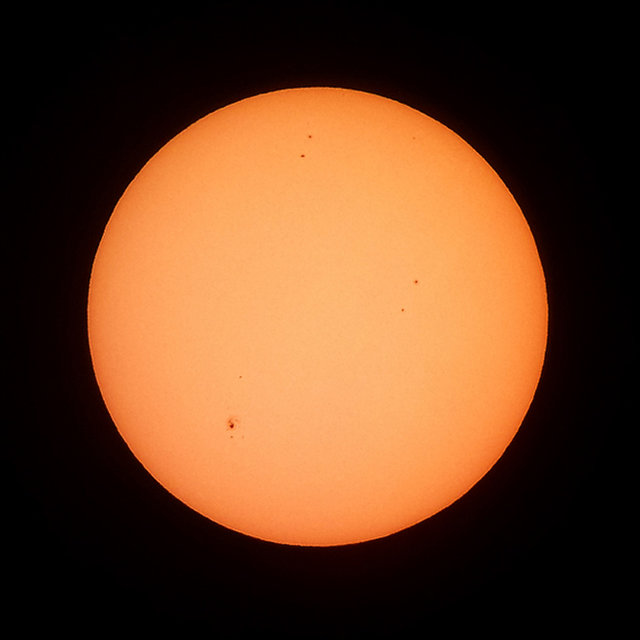
Credit: Imelda Joson and Edwin Aguirre
Use a safe, proper solar filter
When shooting the eclipse's partial phases, be sure to use a solar filter mounted securely in front of your telephoto lens or telescope objective. Don't forget to place a filter over the telescope's finder scope as well.
Metal-coated glass and black polymer filters produce a pleasing yellow or orange image of the sun, while arc-welder's No. 14 glass filters give a light, greenish image. Aluminized Mylar filters show a bluish sun. Baader's AstroSolar Safety Film (made of metal-coated resin) exhibits a white image with a hint of pale purple. Suppliers of solar filters include Meade Instruments, Orion Telescopes & Binoculars, Thousand Oaks Optical, Celestron and Kendrick Astro Instruments.
Be sure to take test shots on the sun well ahead of the eclipse to determine the best exposure to use with these filters.
Set the camera to its highest resolution
To record as much detail and color information as possible, use your camera's highest-quality (least-compressed) JPEG setting, or, better yet, its RAW file format to capture the images. Consult your camera manual on how to change the image-quality setting.
Use a high ISO setting
Set your camera's sensitivity to ISO 400 (or higher) to keep exposures very short, thereby minimizing blurring due to vibrations or tracking errors.
Focal Length and Size of the Sun's Image
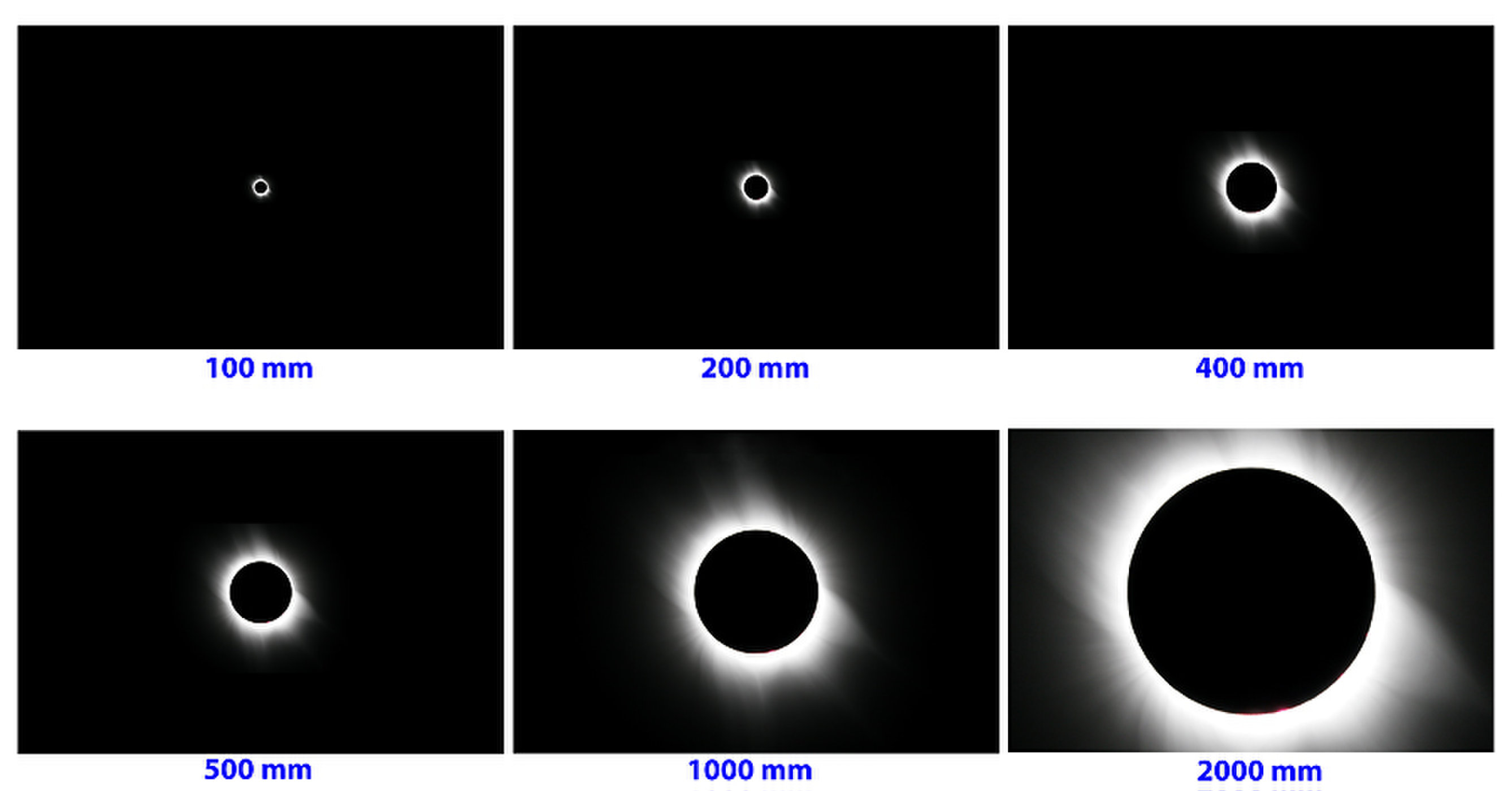
Credit: Imelda Joson and Edwin Aguirre
Joson and Aguirre created this photo illustration, which is adapted from the diagram by Fred Espenak, an astrophysicist emeritus at NASA's Goddard Space Flight Center who specializes in eclipse predictions (earning him the nickname "Mr. Eclipse"). The diagram shows how the size of the sun's image varies in the frame of a digital single-lens reflex (DSLR) camera with a full-frame (35-mm format) sensor, depending on the focal length of the telephoto lens or telescope used. In DSLRs with smaller, APS-C sensors, the relative size of the solar image will appear about 1.6 times larger because of the cropping of the camera's field of view. As a result, you can use a lens of shorter focal length to produce the same image scale of the sun as in the full-frame version.
Switch to manual
Switch your camera shooting mode from Auto (A) to Manual (M) so you'll be able to control its focus and exposure settings. YourDSLR camera's autofocus and auto-exposure functions will not work on the eclipse. The same goes for the camera's pop-up flash; just turn it off completely.

Credit: Imelda Joson and Edwin Aguirre
Focus carefully
Don't let poor focus ruin your images. Allow yourself enough time to focus carefully to get sharp images. If possible, prefocus your camera (without the solar filter) the night before the eclipse using a bright star. Otherwise, focus carefully (through the solar filter) on the sun's limb (the edge of the disk) or on sunspots, if there are some visible, on the morning of the eclipse. Place a piece of adhesive tape on your telephoto's focus ring (or lock the telescope focuser) to keep it from being moved accidentally during the eclipse.
Many DSLRs offer "live-view" mode that allows you to focus manually through the camera's built-in LCD screen in real time. You can even zoom-in to magnify the image up to 10X for more accurate focusing. Be sure to recheck your focus as the eclipse progresses and refine it if needed.
Minimize vibrations
An effect called mirror slap that occurs in DSLRs creates a very small vibration in the camera that can cause blurred images. If possible, use the camera's mirror lock-up feature before each shot to keep vibrations to a minimum. Keep your exposures very short by using a high ISO setting (400 or higher). You should also operate the shutter with an electronic cable release to eliminate camera shake created by your finger pressing on the shutter button. Finally, choose your site so it's shielded from the wind. Erect a windbreak, if needed.
"Bracket" your exposures
Digital cameras have very limited dynamic range, that is, they can't capture the full range of brightness levels of the sun's corona during totality in a single exposure. For best results, use the "bracketing" technique —taking a series of shots at various shutter speeds. This will increase your chances of getting the appropriate exposure for the scene you're interested in.
Try short exposures to record fine details in the inner corona and long exposures to capture faint streamers of the outer corona. Prominences are deceivingly bright, so you'll need to use fast shutter speeds, say, 1/500 seconds to 1/1,000 seconds, depending on your effective focal ratio and ISO setting. (Use Fred Espenak's exposure table at as a guide when bracketing your exposures.)
Don't skimp on memory cards
Be sure to use a reliable, high-speed, large-capacity (16 gigabytes or more) memory card when shooting the eclipse. Get one with the fastest write-read speed you can afford, and keep a backup card in case of any last-minute issues.
Use a fresh battery
DSLRs can easily drain the batteries, especially if you use the LCD screen continuously. Make sure you use a fully charged battery right before first contact, and have a spare one handy, just in case. You don't want to get that flashing low-battery icon at the most critical time.

Credit: Imelda Joson and Edwin Aguirre
Test your imaging setup
Be sure to try out your setup before the eclipse. If possible, take trial shots of the sun to give yourself an idea of what exposure settings to use with your particular telescope and filter combination. These will also reveal any potential problems with focusing and vibrations, as well as internal reflections or vignetting (dimming around the edges of the image). Practice your imaging sequence over and over so you can time your pace and refine it as needed. Remember: Things will unfold very quickly right before and during totality, and you have only one chance to get it right!
If you are planning to fly to your eclipse-observing site, carefully pack each part as you disassemble your gear so you don't leave behind any essential screw, adapter or cable. Also, place delicate optics and cameras in your carry-on baggage to ensure safe handling. Check with your airline or travel agent regarding baggage size and weight restrictions to avoid unexpected fees or delays during check-in and boarding.
Catch the action
Consider bringing a video camcorder or GoPro action camera. If you mount the camcorder on a fixed tripod and set its lens to wide angle, it can record not only the approach and retreat of the moon's shadow and totality itself, but also the excitement of the people observing in the foreground.
Shoot the partial eclipse in hydrogen-alpha
You can also bring along a portable hydrogen-alpha telescope, such as Meade's Coronado PST or SolarMax II series. The so-called hydrogen-alpha line is a narrow wavelength of light radiated by the sun, that can be used to reveal surface structure and texture on the sun's disk, as well as prominences along the solar limb before totality.
H-alpha telescopes allow only the ruby-red light emitted by hydrogen atoms in the sun (at a wavelength of 656 nanometers) to pass through, revealing a wealth of details in the sun's chromosphere layer. Besides prominences, you'll also be able to capture other dynamic features, including plages, filaments, spicules and occasional flares.
Back up everything right away
Immediately after the eclipse, label your memory cards and back up all the image files by copying them into a hard drive, a CD or a flash drive. Keep the originals in a separate folder or drive, and edit only copies of the images.
Process your images
Since the camera's output is already in digital format, it's easy to process your shots using image-editing software such as Adobe Photoshop to enhance the images' brightness, contrast, sharpness and color balance. You can portray the corona's full range of brightness levels by digitally "stacking" several different exposures into a single composite image. You can also "stitch" the frames together to create an eclipse sequence or a GIF animation.
Finally, and most importantly, no matter how crazy it gets, don't forget to take a few moments to enjoy totality with your naked eye or through binoculars. (Just remember to have proper eye protection ready for when totality ends.) No photograph or video can match the real thing. Don't forget to share your experiences and photos with Space.com.
Good luck, and let's hope for clear skies on eclipse day!
Eclipses In History
King Henry's Eclipse, 1133

On August 2, 1133 CE a total solar eclipse occurred in England. A contemporary account stated that “the day darkened over all lands; and the Sun became as it were a three-night-old Moon, and the stars about it at mid-day. Men were greatly wonder-stricken and were affrighted, and said that a great thing should come thereafter.” King Henry I of England (1068 – 1135), the son of William the Conqueror, did die after the eclipse, although his death occurred four years later in 1135 CE as a result of food poisoning from eating too many lampreys (i.e. eels). Despite the four year interval between the eclipse and Henry's death, the passing of King Henry I was widely believed to have been foretold by the eclipse and only served to reinforce the then common belief that eclipses were bad omens for monarchs.
Halley's Eclipse, 1715
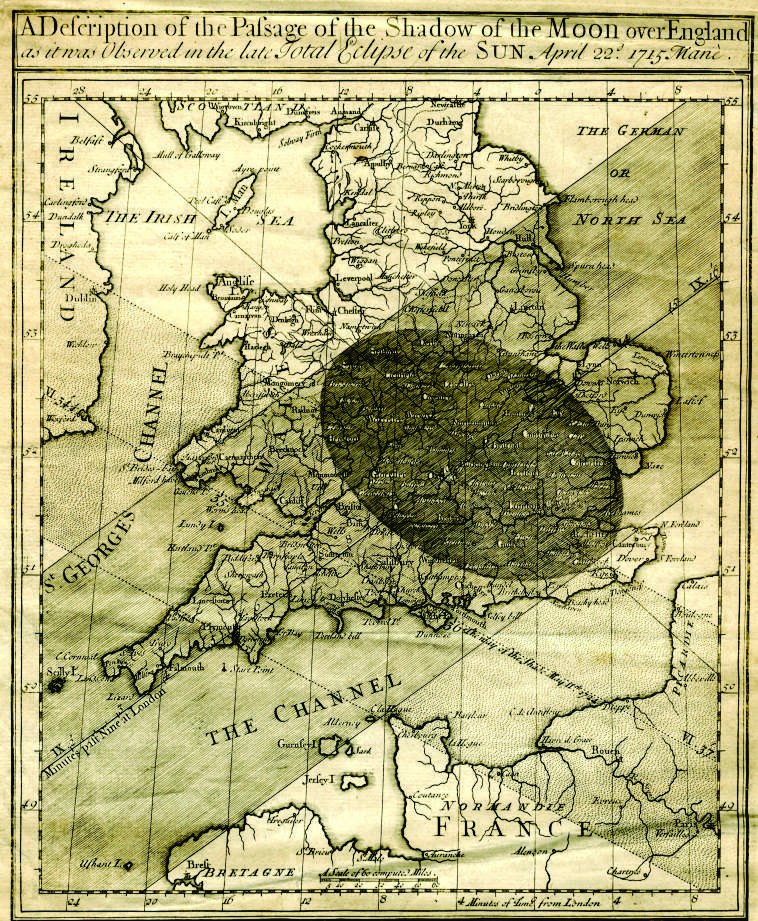
The total solar eclipse of 1715 CE is historically significant because English astronomer and physicist Edmund Halley (1656 – 1742) produced the first map for an eclipse event that showed the predicted path of the umbra on the ground. A careful examination of Halley's map shows that the eclipse is dated to occur on April 22, 1715. This, however, is the old Julian calendar date; England only adopted the “new” Gregorian calendar in 1752. The proper date for Halley's eclipse using the modern calendar is thus actually May 3, 1715.
Nat Turner's Eclipse, 1831

Nat Turner (1800 – 1831) was an African American slave who led a slave revolt in Virginia in 1831. Turner believed that he could hear divine voices and see prophetic visions. He stated that “I had a vision ... I saw white and black spirits engaged in battle, and the sun was darkened.” A solar eclipse occurred on February 12, 1831 CE which Turner interpreted as a message from God urging him to begin planning for a slave insurrection; Turner eventually began his slave revolt on August 21. Although the revolt was quelled after two days, Turner himself evaded capture for an additional two months before eventually being caught. Turner was hanged on November 11. The recent 2016 film The Birth of a Nation recounted the story of Nat Turner's slave revolt.
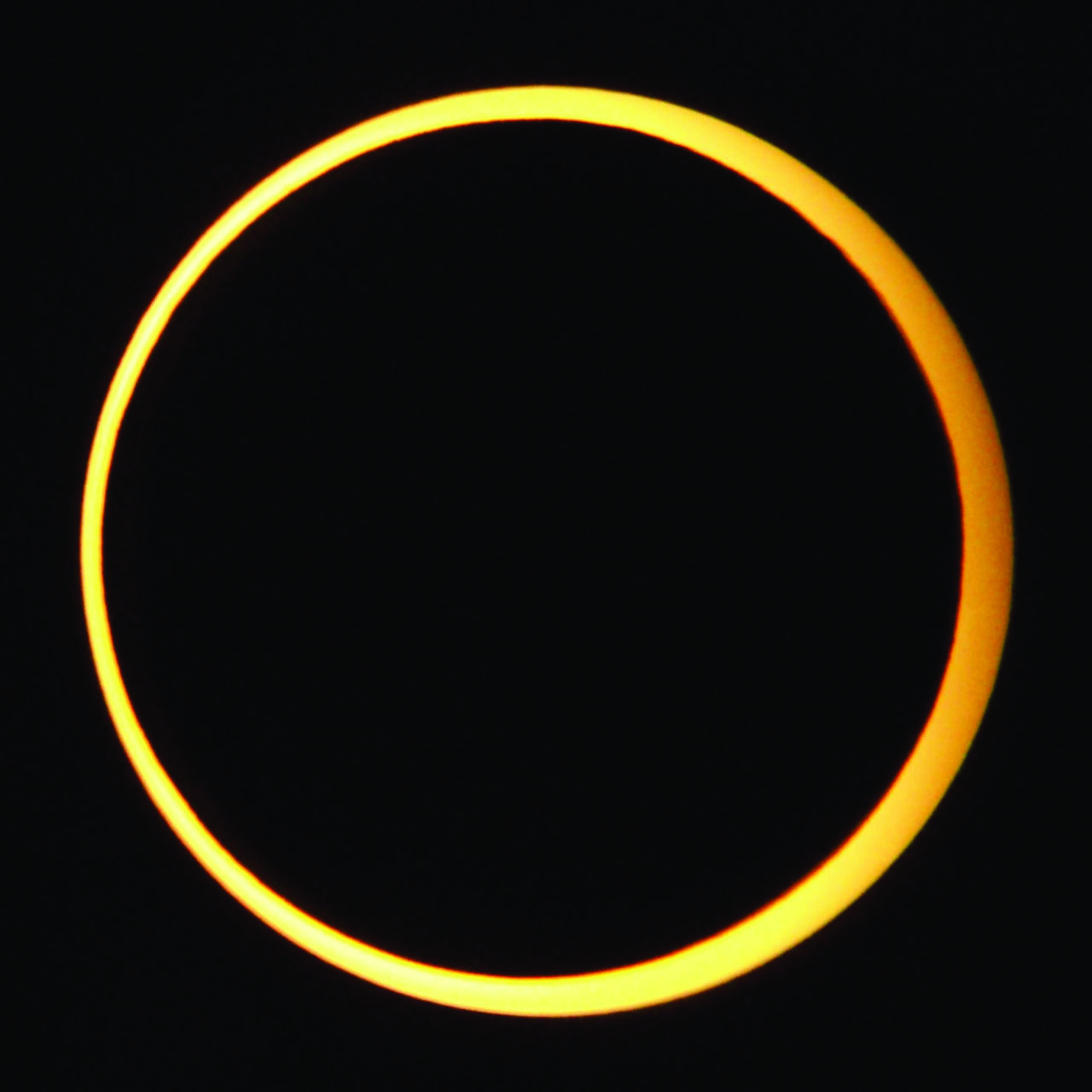
(Note: Turner's eclipse was not a total solar eclipse in which the Moon completely covers the Sun's disk. Turner's eclipse was instead an annular eclipse in which the Moon is too far away from the Earth to completely cover the Sun's disk. A bright ring is still visible around the Sun at maximum coverage during an annular eclipse. Approximately 96% of the Sun was obscured during the annular eclipse that Nat Turner observed on February 21, 1831.)
Einstein's Eclipse, 1919
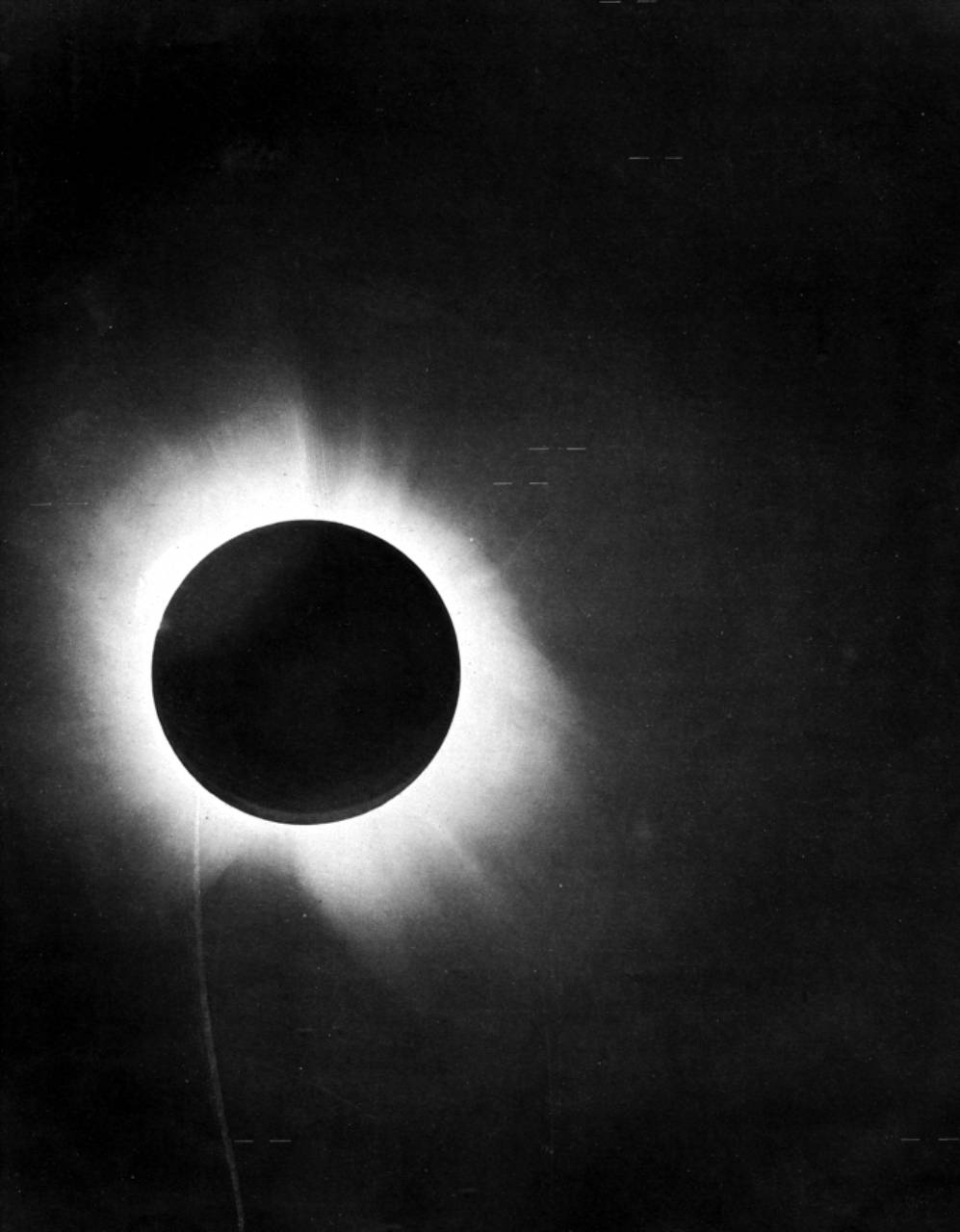
The total solar eclipse of May 29, 1919 CE is important in Science history because it provided the first experimental test of Albert Einstein's general theory of relativity. Einstein's theory had predicted that the very fabric of space would be warped by the presence of large massive bodies like the Sun. This warping would cause light to travel in a curved path near a massive body instead of in a straight line. This prediction was test by Sir Arthur Eddington (1882 – 1944), an English physicist, during the May 29 total solar eclipse. Eddington observed in an expedition to the island of Principe off the coast of West Africa that light from the Hyades star cluster was indeed warped by the eclipsed Sun in complete accord with Einstein's theory.
One of Eddington's actual plates of the 1919 eclipse that helped to confirm Einstein's theory of general relativity.







